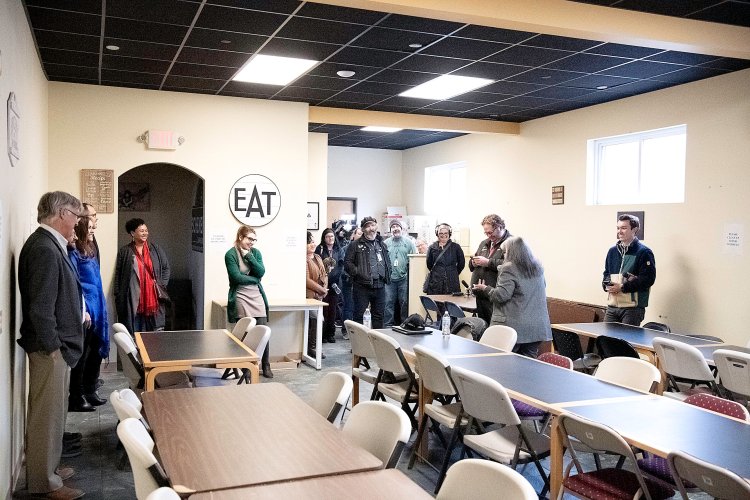
Days with extreme cold are trending upward in Maine. So are days featuring extreme heat.
With that in mind, the Maine Center for Disease Control and Prevention and the Androscoggin County Emergency Management Agency sponsored an extreme weather response planning session and focus group Tuesday morning at the LA 911 Center on Oak Street in Lewiston.
“We view extreme heat and cold as really significant and undersupported public health issue in the state,” Rebecca Lincoln of the Maine CDC said. “We want to make sure we get ourselves ready for extreme weather events, whether they are the type of weather event we have frequently or ones that we expect to increase in the future.”
Nearly two dozen individuals attended the one-hour hybrid meeting. Attendees included representatives of Lewiston, Auburn, Lisbon, Durham, the American Red Cross, the National Weather Service and nonprofits that serve the elderly and the poor.
The group was focused both on the high heat of summer and the bitter cold of winter.
According to the state’s data, cold-related emergency room visits average between 220 and 500 each year, Lincoln said, treating conditions such as frostbite and hypothermia.
“We’re not sure why that is, but we are a cold-weather state,” Lincoln said.
Despite being a cold-weather state, extreme heat is also a growing issue. A heat index of 95 and above has become more frequent.
According to Lincoln, there are between 100 and 350 emergency room visits every summer treating such heat-related issues as heat exhaustion, extreme sunburn, dehydration and heat stroke.

Chris Dillman, director of the Androscoggin County EMA, said the purpose of the meeting was to help improve its hazard mitigation plan.
“We want to gather information, to give us the information we may need to be able to develop a plan to meet that response,” Dillman said. “Our focus is to provide cooling and warming centers to reduce injuries, to make sure we prioritize the marginalized populations, such as the elderly, children, even our outdoor workers.”
To develop an extreme temperature response plan, attendees discussed ways to improve communication, how to respond to the growing crisis with cooling and warming shelters and how to reach vulnerable populations in the community.
Some participants said older residents often don’t want to feel like a burden for others, so they don’t always ask for help or visit warming and cooling centers. Others are reluctant to leave their pets at home.
“We see quite a lot of requests for air conditioning assistance, getting air conditioners to people,” said Becky Sawyer-Manter, president and CEO of Seniors Plus, which provides a variety of services for older residents and those with disabilities. “We have a small amount of money where we can help that. But the concern, too, is the cost of electricity. Older adults are on fixed incomes and electricity is always a concern in their ability to use as much as they should because they try to get by with a little.”
Officials from Maine CDC said it is developing a tip sheet on ways to stay cool at home and at work.
While hot weather is becoming more frequent, Lincoln said officials do not see a trend like they do with extreme cold.
CDC data show that cold-related illnesses have risen over the past decade. Polar vortex events where arctic air pours into the area are difficult to predict, and are likely to become more common in the future, Lincoln said.
Homeless shelters can help some on the coldest nights, but other daytime warming centers, such as libraries, often close by evening.
“We have a day center, technically not a day shelter,” Erin Reed, of the Trinity Jubilee Center in Lewiston, said. “We’re open six days per week year-round. We don’t close due to weather. Every blizzard. we are open for our regular hours.”
Strengthening community connections and outreach are vital to mitigate health risks during extreme temperatures. The stakeholders were urged to come up with policies that will encourage neighbors to look out for one another and improve the safety for all residents.
The Red Cross said it has programs to provide support to communities through the county’s EMA office.
The group plans to meet again next month to continue discussions.
We invite you to add your comments. We encourage a thoughtful exchange of ideas and information on this website. By joining the conversation, you are agreeing to our commenting policy and terms of use. More information is found on our FAQs. You can modify your screen name here.
Comments are managed by our staff during regular business hours Monday through Friday as well as limited hours on Saturday and Sunday. Comments held for moderation outside of those hours may take longer to approve.
Join the Conversation
Please sign into your Sun Journal account to participate in conversations below. If you do not have an account, you can register or subscribe. Questions? Please see our FAQs.